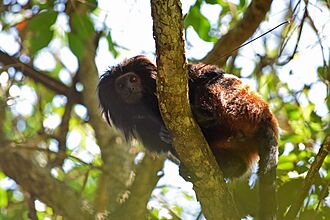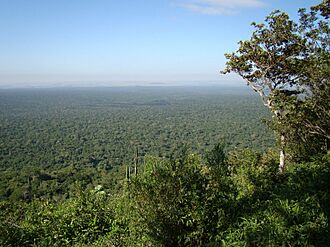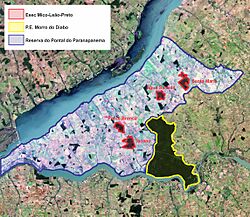Black lion tamarin facts for kids
Quick facts for kids Black lion tamarin |
|
|---|---|
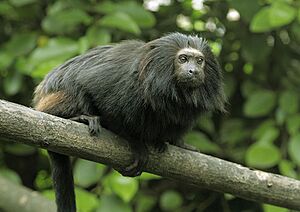 |
|
| Black lion tamarin at Bristol Zoo | |
| Conservation status | |
| Scientific classification | |
| Genus: |
Leontopithecus
|
| Species: |
chrysopygus
|
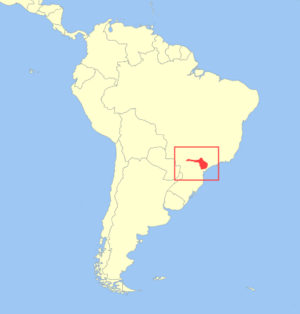 |
|
| Synonyms | |
|
ater Lesson, 1840 |
|
The black lion tamarin (Leontopithecus chrysopygus), also known as the golden-rumped lion tamarin, is a small monkey. It is a type of lion tamarin that lives only in the state of São Paulo in Brazil. Most of them live in the Morro do Diabo State Park. Because they live in such a small area, they are one of the rarest New World monkeys.
People once thought these tamarins were extinct for 65 years. But then, in 1970, they were found again! In 2016, a pair was seen in the Caetetus Ecological Station. This was exciting because no one had seen them there for six years.
In 2020, experts guessed there were about 1,600 black lion tamarins in the wild. About 1,200 of these live in Morro do Diabo State Park. They usually live in groups of 4 to 9 tamarins. They make their homes in both new and old forests around their living area. An adult black lion tamarin usually weighs between 300 and 700 grams (about 10 to 25 ounces).
Contents
What is a Black Lion Tamarin?
How Scientists Classify Them
Scientists used to disagree on how to classify lion tamarins. Some grouped them by where they lived. Others put them all into one species with different types. Now, most scientists agree to classify them mainly by their location.
Sometimes, they also use the sounds the tamarins make. This is like how bird songs help classify different bird species. The black lion tamarin starts its call at the lowest note. It also uses the widest range of sounds compared to other Leontopithecus species.
Life and Habits
What They Eat
The black lion tamarin's diet changes with the seasons. It also depends on where they are living. In dry forests, they eat many kinds of fruits. But in swampy areas, they mostly eat tree gum. Their food choices also change from day to day and month to month.
No matter where they are, tamarins spend a lot of time looking for insects and spiders. They spend about 80% of their foraging time searching for insects. They often look on the forest floor. They have special fingers that help them pry under dry palm leaves, loose bark, and in tree holes. They also sit in trees, usually about four meters (13 feet) up, and look for insects from above.
Black lion tamarins also eat tree gum and fruit. They climb up to ten meters (33 feet) to reach these foods. Since these are easier to find, they spend less time getting them. They spend about 12.8% of their day on gum and fruit. This is much less than the 41.2% they spend looking for insects in tall trees.
Having Babies
Black lion tamarins have babies during the spring, summer, and fall. In Brazil, this is from August to March. Female tamarins usually have one litter of babies each year. However, about 20% of females have two litters a year. Most litters have two babies.
Most baby mammals are born with an equal number of males and females. But black lion tamarins usually have more males than females. About 60% of their babies are male, and 40% are female. Sadly, most baby deaths happen in the first two weeks after birth. Babies born to first-time mothers have the lowest chance of survival. Tamarins in the wild are 10% more likely to survive to adulthood than those in zoos.
Sharing Food
For the first few months, baby tamarins cannot find food by themselves. They ride on their parents' backs and get food from them. They drink milk for the first 4 to 5 weeks. After that, parents and other group members share food with the baby. This sharing happens when parents offer food or when the baby asks for it.
Babies get most of their food, especially insects, from others until they are about 15 weeks old. The most food is offered when the baby is around 7 weeks old. After 15 weeks, sharing slowly decreases. It usually stops by the time the baby is 26 weeks old.
How They Talk to Each Other
The black lion tamarin is the largest of the Leontopithecus species. It also makes the lowest-pitched calls. Their calls use longer notes than other tamarin species. Black lion tamarins use calls for many reasons. They call to protect their territory and to stay together as a group. They also call to find a mate or to contact group members who might be lost. Most calls are heard in the morning. These calls often happen when mated pairs reunite. Most pairs are monogamous, meaning they have one mate. But sometimes, a female might mate with more than one male.
Protecting the Black Lion Tamarin
The IUCN Red List says the black lion tamarin is an endangered species. This means its population is shrinking. The biggest danger to them is the destruction of their home through deforestation. They are also hunted in forests that are not protected. For example, in places like Fazenda Rio Claro and Fazenda Tucano, there are fewer tamarins per square kilometer.
People have tried to help black lion tamarins by bringing them into zoos. They also work to save the small amount of habitat left in the Morro do Diabo State Park. These efforts aim to help them breed more. However, if their numbers keep dropping in the wild, black lion tamarins might only be found in Morro do Diabo.



